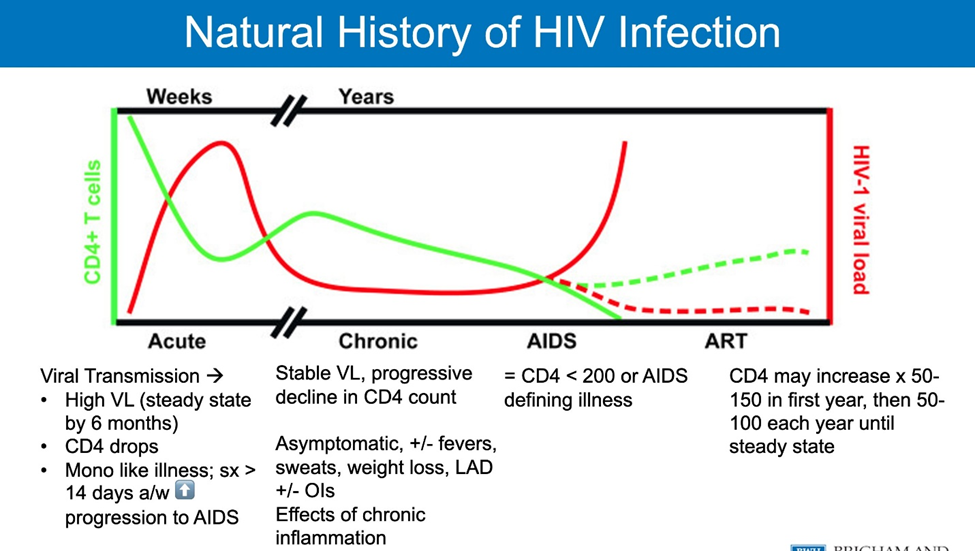The nurse reviews the CD4 cell count of a client who is HIV-positive. A result less than which count would indicate to the nurse that the client has AIDS?
1,000 cells/mm3
700 cells/mm3
450 cells/mm3
200 cells/mm3
The Correct Answer is D
A. 1,000 cells/mm3:
A CD4 cell count of 1,000 cells/mm3 is within the normal range for a healthy individual. In HIV-positive individuals, a CD4 count at this level would generally indicate that the immune system is functioning well and has not been significantly compromised by the virus. Therefore, a CD4 count of 1,000 cells/mm3 would not suggest a diagnosis of AIDS.
B. 700 cells/mm3:
Similarly, a CD4 cell count of 700 cells/mm3 is also within the normal range for immune function. While this count may be lower than the typical CD4 count in a healthy individual, it is still considered relatively high and would not indicate immune compromise to the extent seen in AIDS.
C. 450 cells/mm3:
A CD4 cell count of 450 cells/mm3 is also within a range that suggests the immune system is functioning reasonably well. While it may be lower than normal, it is not at a level indicative of severe immune suppression characteristic of AIDS.
D. 200 cells/mm3:
When the CD4 cell count drops below 200 cells/mm3, it indicates significant immune suppression and an increased risk of opportunistic infections. This threshold is used to diagnose AIDS in HIV-positive individuals. At this level, the immune system is severely compromised, leaving the individual vulnerable to various infections and diseases associated with AIDS.

Nursing Test Bank
Naxlex Comprehensive Predictor Exams
Related Questions
Correct Answer is C
Explanation
A. Encouraging range-of-motion exercises: Range-of-motion exercises are generally encouraged post-hysterectomy to prevent complications such as blood clots and promote circulation. This action is appropriate and not contraindicated.
B. Ambulating the client: Ambulation is an essential aspect of postoperative care to prevent complications like atelectasis, pneumonia, and deep vein thrombosis (DVT). This action helps improve circulation and aids in the recovery process. It is appropriate and not contraindicated.
C. Applying elasticized stockings: Elasticized stockings, also known as compression stockings, are commonly used postoperatively to prevent deep vein thrombosis (DVT) by promoting blood flow in the legs. However, in the case of abdominal hysterectomy, if the incision site is below the level of the stockings, they may impede circulation to the surgical site and hinder wound healing. Therefore, this action may be contraindicated depending on the specific circumstances of the surgery and incision site.
D. Massaging the client's legs: Massaging the client's legs is generally not recommended post-hysterectomy, especially in the immediate postoperative period. Manipulating the legs could potentially disrupt healing tissues, increase the risk of bleeding, or cause discomfort to the client. Therefore, this action may be contraindicated.
Correct Answer is B
Explanation
A. Client has a twin sister.
Having a twin sister does not directly increase the client's risk of developing preeclampsia. While twin pregnancies are associated with higher rates of certain complications, such as preterm birth and gestational hypertension, having a twin sister herself does not inherently increase her risk of preeclampsia.
B. Her mother had preeclampsia during pregnancy.
This is the correct choice. A history of preeclampsia in the client's mother is a significant risk factor for preeclampsia in the client herself. Preeclampsia has a genetic component, and women with a family history of the condition, especially in their mothers, are at increased risk of developing it during their own pregnancies.
C. This is the client's second pregnancy.
While the number of pregnancies a woman has experienced can influence her risk of certain pregnancy complications, such as placental abnormalities, it is not as strong a risk factor for preeclampsia as a family history of the condition. Preeclampsia can occur in both first and subsequent pregnancies, regardless of the number of pregnancies a woman has had.
D. Her sister-in-law had gestational hypertension.
Gestational hypertension is a related condition to preeclampsia and shares some risk factors, such as high blood pressure during pregnancy. However, a sister-in-law having gestational hypertension does not directly increase the client's risk of preeclampsia. While it may suggest a family predisposition to hypertensive disorders during pregnancy, it is not as specific a risk factor for preeclampsia as a direct family history of the condition, such as in the client's mother.

Whether you are a student looking to ace your exams or a practicing nurse seeking to enhance your expertise , our nursing education contents will empower you with the confidence and competence to make a difference in the lives of patients and become a respected leader in the healthcare field.
Visit Naxlex, invest in your future and unlock endless possibilities with our unparalleled nursing education contents today
Report Wrong Answer on the Current Question
Do you disagree with the answer? If yes, what is your expected answer? Explain.
Kindly be descriptive with the issue you are facing.
